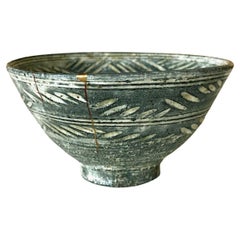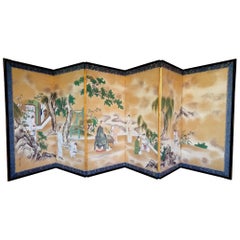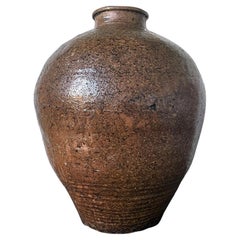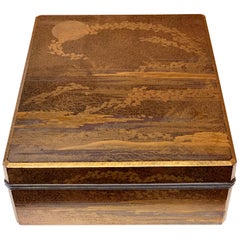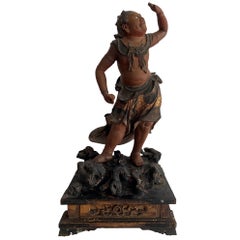TISHU Furniture
16
to
16
16
16
16
147
311
590
103
154
193
175
21
4
17
13
28
44
49
69
30
25
9
6
4
3
3
16
16
11
5
1
Period: 17th Century
Antique Korean Mishma Tea Bowl Chawan Joseon Dynasty
Located in Atlanta, GA
A Korean Hori-Mishima Chawan (tea bowl) circa 16th-17th century (Joseon Dynasty). The tea bowl is of an upright conical form supported by a high foot ring. It was decorated with incised brushwood fence patterns filled with white slip on both the interior and exterior surface. These dominant motifs were spaced by three encircling double lines. Seven chrysanthemum flowers (inka) were stamped on the lower interior surrounding a swirling tea well on the bottom. There are six spur marks known as Meato in Japanese on the interior bottom and a pointy spot in the center of the foot ring known as Tokin. Two crack lines were historically repaired by superb Kintsugi, adding a mysterious wabi-sabi appeal to the piece.
The Hori-Mishima bowl was also known as Gohon Mishima. It was made in Bushan Kilns of the Southern Gyeongsang Province specifically for the Japanese market in the 16th-17th century, when the tea ceremonies in Japan demanded such ware. The bowl comes with a purple fabric pouch...
Category
Antique 17th Century Korean Other Ceramics
Materials
Ceramic
Rare Antique Japanese Folding Screen by Kano Tanshin
By Kano Tanshin
Located in Atlanta, GA
An exquisite Japanese folding screen painted and signed by Kano Tanshin (Morimasa) (1658-1719), circa early Edo Period. An important member of the Kano painter family, the son of Kano Tanyu...
Category
Antique 17th Century Japanese Japonisme Paintings and Screens
Materials
Brass
Large Japanese Antique Tokoname Tsubo Stoneware Floor Jar
Located in Atlanta, GA
A massive antique stoneware storage jar (known as tsubo in Japanese) circa 16-17th century (Muromachi to early Edo period). The heavily potted jar is of a typical "medieval" form with swelled shoulder, short neck and tapered body, made for vernacular use in the kitchen. The jar is unadorned except the groove lines around the short neck and along the lower half of the body. The surface is covered with a thin glaze with black markings and runoffs resulted from the iron slip interacted with ashes in the kiln fires.
Tokoname ware is one of the six ancient kilns in Japan dated to the 9th century and made in Aichi Prefecture in central Japan. Using local iron-rich clay, it is renowned for its unglazed thick-walled storage jars with a strong Mingei (folky) appeal. When the chado (tea ceremony) became highly appreciated in the 15th century during the Muromachi period, tea masters, equivalent to today's taste makers...
Category
Antique 17th Century Japanese Archaistic Ceramics
Materials
Stoneware
Large Japanese Antique Shigaraki Tsubo Jar
Located in Atlanta, GA
An antique Japanese stoneware storage jar, known as tsubo from Shigaraki kiln, circa 17th-18th century (early Edo possibly Momoyama period)....
Category
Antique 17th Century Japanese Japonisme Ceramics
Materials
Ceramic
Large Japanese Lacquer Box Early Edo Period Ex-Christie's
Located in Atlanta, GA
A large lacquer Ryoshibako (Paper box in Japanese) finely decorated with Maki-e circa 17th century early Edo period. The box is of an impressive size and was used to store paper documents. Both sides of the lid were elaborately decorated with maki-e and the edge was befitted with lead rim, an early practice before the silver rim became common later. The interior and base were finished in Nashiji. The night scene on top surface of the lid depicts flocks of chidoris flying in formation from a sea shore swaying with reeds under a full moon, using hiramaki-e in both gold and silver. Ribbons of clouds were achieved with different densities of gold powder. The underside, in contrast, shows a crescent moon in takamakie-e above the sea with ferns and reeds. Chidoris, the plovers, are symbolic in Japanese culture as "thousands of blessings" and longevity. The Namichidori, the pattern in which the chidori flies in the nami (wave) represents the eternal love and safety of couples and families. For detailed references on the historical background and the use of chidoris on lacquerware, see the reference below.
This very lacquer box was featured for sale as lot 339 in Christie's London Sale Japanese Art...
Category
Antique 17th Century Japanese Japonisme Lacquer
Materials
Wood, Lacquer
Japanese Lacquered and Gilt Wood Buddhism Statue from Edo Period
Located in Atlanta, GA
An exceptional and wood statue of Buddhism Guardian Seitaka Doji from Japan circa Edo period (1603-1868), likely the earlier part of 17th century. One of two chief attendants of Fudo...
Category
Antique 17th Century Japanese Japonisme Sculptures and Carvings
Materials
Metal
Antique Japanese Hanging Scroll Attributed to Iwasa Matabei
Located in Atlanta, GA
An antique ink and color on paper hanging scroll (kakejiku) with brocade border. It appears to be a fragment of a larger hand scroll depicting a procession of a lord with his entoura...
Category
Antique Early 17th Century Japanese Japonisme Paintings and Screens
Materials
Silk, Paper
Pair of Japanese Ink Hanging Scrolls Kano Tanyu
By Kano Tan'yu 1
Located in Atlanta, GA
A fine matching pair of hanging scrolls ink on paper mounted in green brocade borders circa Edo period (17-18th century). The Kano school painting depicts wild geese in the reeds by the margin of water, a popular subject borrowed from the Chinese tradition. Both painting were signed as Tanyu with a red seal of Morinobu, his birth name. The storage box is also present and was inscribed with the title Painting of Geese and Reeds and Kano Tanyu...
Category
Antique Late 17th Century Japanese Japonisme Paintings and Screens
Materials
Wood, Paper
Antique Japanese Lacquered Incense Box Kobako Ex-Christie's
Located in Atlanta, GA
An old Japanese lacquered small box likely used to contain incense powder called Kobako, circa Momoyama to early Edo period (16-17th century). The rectangular form box with a fitted ...
Category
Antique 17th Century Japanese Japonisme Lacquer
Materials
Lead
Korean Gohon Chawan Tea Bowl for Japanese Market Joseon Dynasty
Located in Atlanta, GA
A ceramic chawan (tea bowl) circa 17-18th century fired in the Busan kiln in Korean specifically for the Japanese market. The kilns were run by the So c...
Category
Antique 17th Century Japanese Edo Ceramics
Materials
Ceramic
Antique Korean Ceramic Gohon Chawan Tea Bowl Joseon Dynasty
Located in Atlanta, GA
A ceramic chawan (tea bowl) circa 17-18th century fired in the Busan kiln in Southern Korean specifically for the Japanese market. The kilns were contro...
Category
Antique 17th Century Japanese Edo Ceramics
Materials
Ceramic
Korean Ceramic Ki-Irabo Tea Bowl Chawan Joseon Dynasty
Located in Atlanta, GA
A ceramic chawan tea bowl made in Korea for Japanese market circa 17th century. The chawan is identified as Ki- Irabo type (Yellow Irabo). Irabo bowls w...
Category
Antique 17th Century Korean Other Ceramics
Materials
Ceramic
Korean Ceramic Irabo Tea Bowl Chawan Joseon Dynasty
Located in Atlanta, GA
A ceramic chawan tea bowl made in Korea for Japanese market circa 17th century. The chawan is identified as Irabo type. Irabo bowls were essentially con...
Category
Antique 17th Century Korean Other Ceramics
Materials
Ceramic
Korean Ceramic Kakinoheta Chawan Tea Bowl
Located in Atlanta, GA
A "Kakinoheta" type ceramic chawan (tea bowl) made in Korean during Joseon dynasty circa 16th-17th century. The bowl has a slight irregular flat shape w...
Category
Antique 17th Century Korean Other Ceramics
Materials
Ceramic
Japanese Lacquered Maki-E Fubako in Kodaiji Style
Located in Atlanta, GA
A rare Japanese lacquered wood fubako decorated in Kodaiji maki-e style circa early 17th century the beginning of the Edo period, possibly early toward the end of the Azuchi-Momoyama period. The rectangular, long and slim box features a deep lipped lid with slightly rounded corners, a conforming lower box with two bronze medallion rings with tasseled...
Category
Antique Early 17th Century Japanese Edo Lacquer
Materials
Wood, Lacquer
Korean Ceramic Ido Tea Bowl Chawan Joseon Dynasty
Located in Atlanta, GA
A ceramic stoneware chawan tea bowl made in Korea circa 16-17th century. The chawan is identified as Ko-ido (small ido) due to its size and form. Ido bowls were made since 15th centu...
Category
Antique 17th Century Korean Other Ceramics
Materials
Ceramic
Related Items
Antique Japanese Kano School Painting by Yosenin Korenobu
Located in Prahran, Victoria
Six-panel Kano School tiger screen by Yosenin Korenobu (1753-1808). Sumi-e ink on paper, late 18th century.
Dimensions: H 169cm x W 382cm.
Category
Antique Late 18th Century Japanese Edo Paintings and Screens
Materials
Wood, Paper
Japanese Meiji Period Carved Wood Okimono Man with Rabbits
Located in Newark, England
The charming figure, carved from a single piece of wood is exceptionally carved showing the male figure with humorous expression holding two Rabbits one by the ears and the second under his arm. A third Rabbit stands at the feet of the male looking up, each rabbit with a different expression. The male figure is wearing traditional Japanese attire with his hair tied back stood upon a naturalistic base. The figure dates to the Meiji Period (1868-1912) circa 1900.
Notes The Rabbit is one of the 12 animals to feature in the Japanese Zodiac signs which follows the Chinese astrological system along with the Rat, Ox, Tiger, Rabbit, Dragon, Snake, Horse, Goat, Monkey, Rooster, Dog, Pig. Such division is connected with the Jupiter cycle around the Sun, which lasts about 12 years. As 2023 is the year of the Rabbit...
Category
Antique Early 1900s Japanese Meiji Sculptures and Carvings
Materials
Wood
Early 20th Century Japanese Cherry Blossom Screen by Kano Sanrakuki
Located in Kyoto, JP
Cherry Blossoms
Kano Sanrakuki (1898-1981)
Showa period, circa 1930
2-panel Japanese Screen
Color, gofun and gold leaf on paper
Against a backdrop of gold-leafed ground, the lichen covered trunk and branches of the life-sized cherry blossom tree reach out and beyond the confines of the pictorial surface. The overall composition has a feeling of flatness which draws emphasis to the surface and the three-dimensionality of the cherry blossoms. Painstakingly built-up layers of thickly applied shell-white gofun detail the voluminous blossoms and cover large areas of this tour-de-force of Japanese Nihonga painting. By simplifying the background, minimizing the number of colors and depicting the blossoms with such heavy relief, the artist has emphasized the stunning presence of the cherry tree. The type of tree depicted is the Yae-Zakura; a double-layered type of cherry blossom famed for its beauty and strength. When we think of Japanese cherry blossoms, the first thing that comes to mind is Somei Yoshino variety, which has a single flower with five almost white petals. This type is fragile and easily blown away by strong wind or rain. Most of the double-flowered cherry blossoms begin to bloom when the Somei-Yoshino falls, and the flowering period lasts longer than that of the Somei-Yoshino.
Kano Sanrakuki originally studied painting at the Kyoto City Arts and Crafts School under the tutelage of Yamamoto Shunkyo...
Category
Early 20th Century Japanese Showa Paintings and Screens
Materials
Gold Leaf
Japanese Lacquer Hokai Box, 19th Century
Located in Pasadena, CA
This is a good example of a traditional Japanese Hokai shell storage box for the Kai-awase game. This box is well-detailed in chased brass appliques and makie. The box is in overall ...
Category
Antique Late 19th Century Japanese Japonisme Lacquer
Materials
Wood, Lacquer
Large Antique Qing Dynasty Famille Rose Elaborately Hand-Painted Bowl or Basin
Located in Hamilton, Ontario
This very large and substantial bowl or basin is signed by and unknown artist and originates from China, dating to approximately 1920 and done in the period Chinese Export style. The...
Category
Early 20th Century Chinese Chinese Export Ceramics
Materials
Pottery
Sasaki Shoraku III Signed Japanese Raku Pottery Chawan Tea Bowl with Signed Box
Located in Studio City, CA
A wonderful Raku-fired pottery Chawan tea bowl by a renowned Japanese pottery master and one of Kyoto’s most prominent and best-known Raku-yaki potters Sasaki Shoraku III (1944- ). The work features a beautifully contoured body and dark rich glaze.
The Shoraku line began when the grandfather of the current potter established a kiln near the famous Kiyomizu Temple, nestled at the foot of the eastern mountains...
Category
20th Century Japanese Showa Ceramics
Materials
Pottery
H 4.75 in W 6 in D 6 in
19th Century Large Japanese Imari Ginger Jars
Located in New York, NY
A large and very fine condition pair of antique Japanese Imari Ginger jars from the second half of the 19th century. Each is 12 inches in diameter and...
Category
Antique 1860s Ceramics
Materials
Ceramic
Japanese Momoyama Period Black Lacquer and Mother of Pearl Box, 16th Century
Located in Austin, TX
A fine and unusual Japanese black lacquer and mother of pearl inlaid box, Momoyama Period, 16th century, Japan.
The large box and cover featu...
Category
Antique 16th Century Japanese Edo Lacquer
Materials
Lacquer, Abalone
Signed Mid 19th C. Edo/Meiji Period Miniature Lacquer Stacking Cabinet, Japan
Located in Oxfordshire, United Kingdom
The highly decorated tray in the form of a table frames a series of three stacking boxes, a further three lidded boxes and a tray concealed within, raised on ogee bracket feet.
This...
Category
Antique 19th Century Japanese Meiji Lacquer
Materials
Lacquer
Free Shipping
H 4.89 in W 5.12 in D 3.51 in
Japanese antique wooden Buddha statue/Folk Buddha/Edo period/1603-1868
Located in Sammu-shi, Chiba
This is an old Japanese Buddhist statue made around the Edo period.
The material is believed to be cypress or cedar.
The square pedestal at t...
Category
Antique 17th Century Japanese Edo Sculptures and Carvings
Materials
Cypress
H 16.93 in W 6.11 in D 5.52 in
Antique Japanese Wood Block Printed Table Top Folding Screen
Located in San Francisco, CA
Antique Japanese small table top four panel folding screen.
Wood block print on paper.
First quarter 20th century.
Perfect to use as wall art.
Category
Early 20th Century Japanese Meiji Paintings and Screens
Materials
Paper
Vintage Japanese "Flower Cart" Folding Screen
Located in New York, NY
A traditional style Japanese four panel folding screen depicting a flower cart full of red and white flowers.
10198
Category
